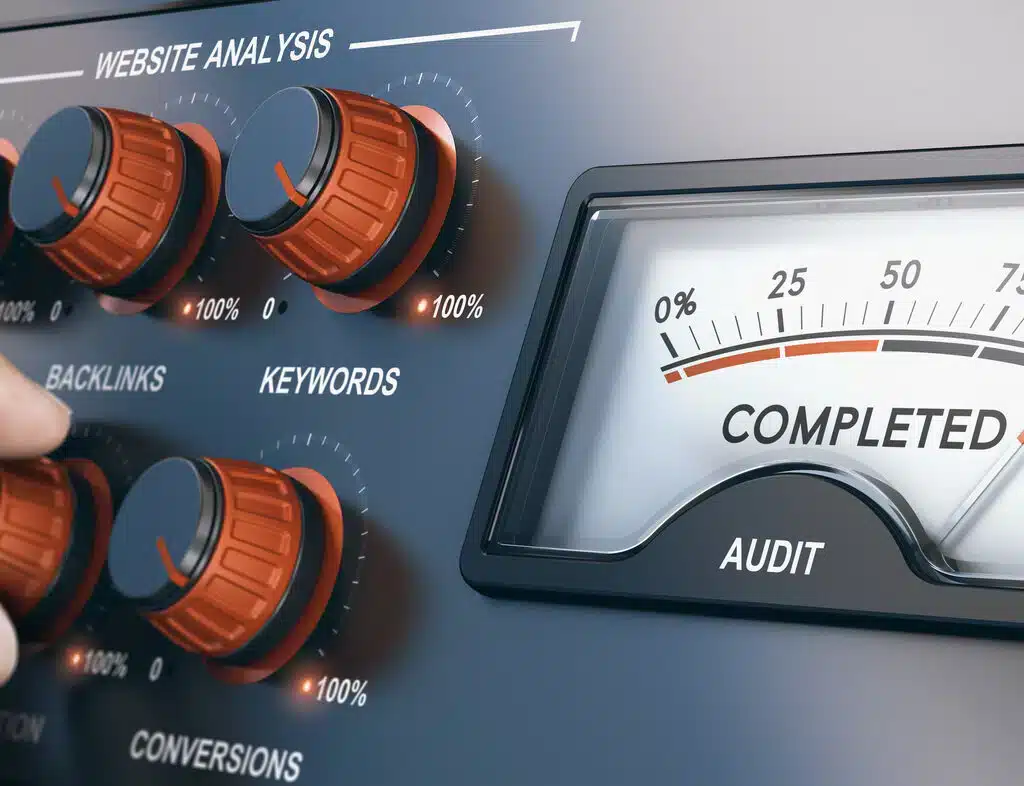Enterprise SEO Audit: Energise Your Website to Boost Conversions!
Enterprise SEO Audit to Boost Your B2B Tech Business
Has your technology business website not been performing to its full potential? No? Not sure? It might be time for an enterprise SEO audit.
An SEO audit will help you refine your online marketing strategy and optimise your spending. You will be set on the path to a website that performs better across the board. That, in turn, will help your business grow.
So, if you’re concerned about your website’s health, let us do a full checkup and diagnose the problem. Find out more about how our comprehensive SEO audit will help turbocharge your rankings.
What’s Our Enterprise-Level SEO Audit Strategy?
Conducting an enterprise SEO audit is essential for understanding how to best structure your website, so it is successful. And, a website’s performance depends on these factors:
- The content
- On-page SEO
- Off-page SEO
- Technical factors
- Industry-specific standards
As such, we plan our SEO audit strategy to target and evaluate each of these factors. There are multiple checkpoints under each, and we go through them all.
Wherever there is a problem or room for improvement, we flag the issue.
Once we have a complete list of problems, we plan your SEO strategy. The result? You get a very relevant, very focused plan of action.
In that plan, we detail everything that needs work. And, we’ll gladly implement that for you as well.

Our Comprehensive Enterprise SEO Audit Checklist
As we mentioned earlier, five factors affect how well your website and pages rank. Here’s what we check for each one of them.
Content Audit
Even though, technically, content is a part of on-page SEO, it is important enough that we review it separately. That’s because not only do you need to consider the existing content on your website but also any missed content opportunities.
In your existing content, we try and find out if there’s any duplicate content, which is multiple pages saying the same thing.
We also look for “thin” content, which is pages that have less than 200 words.
The content audit should include keyword analysis. What search queries are you showing up for? Are there any search keywords that your competitors rank for, but you don’t? If there are, what sort of content could help you compete with them? This gap analysis is an important part of an enterprise SEO strategy.
We will also check to see if there are any featured snippet opportunities that you’re missing out on. Featured snippets are the brief answers you get on the search engine results page (SERP) when you ask a question. It’s prime real estate, because it makes your page stand out in the results.
On the whole, this audit will tell you how you can make your content perform better.
On-Page SEO Audit
On-page SEO is the process of optimising each page of your website so that search engines know what you do and the information that is available there. At a user-experience (UX) level, we check how the pages are structured and image information.
It’s important to follow the prescribed content structure, which means obeying the heading hierarchy. For example, each page should have a single H1 (Heading 1) tag. This is the main title and tells the readers what they can expect to learn on the page. The content should then be broken down into subheadings, and set in a proper hierarchy. That means H2s should contain H3s, which should contain H4s and so on.
Search engines also look at internal links. These are often used to determine how important a page is. For example, nearly every page might link back to the home page because that’s the “face” of your online marketing. Most websites use the logo for that, as it’s present on all pages and is an intuitive way to navigate to the home page.
Then, you might have your main service or product page as the next most important one. This should also have several links pointing to it within the website.
If you have any pages that are not linked from another page, they’d be considered “orphan pages”. These pages exist on your website but neither your users nor search engine crawlers will be able to find them when navigating the website.
(Note: the pages will still be searchable. You can still find them in search results. There just won’t be a way to navigate to them organically when browsing the website.)
One of the ways a search engine determines what your page is about is from its SEO title and meta description. Pages on your site with improper meta information will not do very well in search.
According to SEO best practices, the SEO title should be under 60 characters and should either start with the keyword or have it very close to the front. Similarly, the meta description should be under 160 characters. Whilst it is not one of the ranking factors that Google considers, it is important for enticing people to click on your page when it appears in the SERPs, which has an impact on SEO. That’s why it can help for it to have the keyword and also be imminently clickable.
To boost your SEO performance, we will check your website’s SEO titles and meta descriptions to ensure they are optimised and appropriate.
Any images on the page should ideally have the keyword in their filename.
They should also have a keyword-rich alt tag. The alt tag is a description of the image, that is not normally visible on the page.
That description helps both search engine spiders and people who are visually impaired. Neither can see the page, so alt tags can give them additional contextual clues. It tells them what the image shows and how it relates to the contents of the page.
So, they make for better UX as well as good SEO practice.

Off-page SEO Audit
Off-page SEO, also known as backlink building, is another important consideration when you do an enterprise SEO audit. As the name suggests, off-page SEO looks at how many mentions you have outside your website, including on social media.
Any mention of you on another website, whilst also linking back to you, is called a backlink.
In our backlink audit process, we look at other sites linking to you and how they affect your ranking. And, if you don’t have many high-quality backlinks, we will also help you plan a strategy to get more.
Backlinks are prioritised based on relevance and expertise. You want backlinks from other websites that are either in the same industry as you or are in a closely related one. For example, if you sell a cybersecurity solution, you don’t want backlinks from a pet care website.
I mean, they may have a good reason to talk about you—maybe you made their customer database really secure. However, Google will not take that mention the same weight as, say, a mention in a cybersecurity publication.
A reputed cybersecurity journal will also be considered an expert in your industry. If it is widely known, cited, and referenced, then it will come with a reputation of excellence (which, in the SEO world, is called “Domain Authority (DA)”).
When you get a backlink from them, they “share” some of that authority with you. Due to that, search engines will assume you’re an expert in your domain. So, it will consider your content and web pages more relevant to related search queries.
If you’ve been following the evolution of SEO, you will know that there was a time when all backlinks were thought to be good for SEO. However, as people started gaming the system, Google cottoned on and became a bit more discerning.
Now, the search giant has decided that while relevant and expert sites are good for your backlink profile, certain dodgy sites can be bad for it. These backlinks, called “toxic links” can lower your page’s ranking.
Another factor that could be relevant for your backlink profile—and therefore, performance—is the anchor text used for the backlinks. Anchor text is the name given to the words which contain the link. For example, let’s take this as an example: Geeky Tech.
In that link, the words you see are “Geeky Tech” and they link to this page: https://www.geekytech.co.uk/
Here, “Geeky Tech” is the anchor text.
In general, Google prefers a relevant keyword as the anchor text. So, “B2B SEO Agency”, “Technical SEO Agency”, or “SEO Services Provider” could all be used as anchor text in our example.
However, when search engines see all backlinks come with keyword-rich anchor texts, they get suspicious. It’s not natural for every single mention of a website or a page on that website to be optimised.
That might suggest that you’re engaging in SEO practices that aren’t quite above board. And, as a result, Google might penalise you for it.
Technical SEO Audit
So far, we’ve checked factors that your users see and experience in your website audit. What a technical SEO audit looks at what the search engines see.
In this, we check factors like:
A properly-configured sitemap is exactly that to a search engine—a map that it can use to navigate the website. It lists all the pages that you want the search spiders to crawl.
An XML sitemap is even more important for an enterprise website because it has thousands of pages. You want search engines to know their order of importance and tell them which ones need to be crawled more frequently.
Plus, if you add any new pages, you can add them to the sitemap. That way, search engines immediately know to crawl and index them.
The robots.txt file is for exactly the opposite purpose. That tells the search engines which pages you don’t want to be crawled.
When you want search engines to crawl through pages you index them. If they aren’t indexed properly, they will not show up on the SERPs. That can be problematic if you have spent time and money optimising them.
At the same time, there are pages you don’t want visible on the SERPs—your 404 error page and the “Thank You” page when people have filled out a form, among others. These should be marked no-index.
Improper indexing will result in important pages not showing up at all, while others you don’t want people to see might be searchable.
A properly set up and validated schema markup can make your pages eligible for rich results in the SERPs.
This helps your pages get the visibility they deserve, along with all the information that might tempt users onto your website.
We also check for keyword cannibalisation, which is a situation where you have two pages optimised for the same keyword. As a result, neither is performing brilliantly.
The URL structure is also important. Older URLs often contained numbers and letters, which didn’t quite say what the page was about.
Now, however, you do want URLs to be short, readable to humans, and contain the main keyword as well. We check your URL structure and make recommendations if it’s not quite up to the mark.
Redirects are necessary, especially for an established enterprise website, as pages are removed, moved elsewhere in the hierarchy, or merged with others over time. If a page is deleted, it makes for a better UX for it to be redirected to a similar or relevant page instead of a 404 page.
If you have moved a page temporarily, it should have a 302 redirect as opposed to a 301 redirect, which is for a permanent relocation.
Also, large corporate websites could suffer from redirect chains. That’s when a page has too many redirects.
For example, a page was moved, necessitating a redirect to location A. Over time, the page was moved again a couple of times, so now the redirects from location A to B to C to D.
Ideally, there should be only one redirect, from A to D. Too many redirects can also affect your page’s performance.
A broken link links to a page on your website that either no longer exists or has been moved without being properly redirected. As a result, anyone clicking on the link is taken to a 404 error page.
Whether a broken link is internal or off-page, it reflects badly on your website. So, we check all links on the website to ensure that there are no broken ones.
Big websites often encounter the problem of repeated content. Some pages might need to use the same, or very similar copy, which counts as duplicate content in Google’s eyes.
That dilutes the efficacy of your SEO, as the search engines wouldn’t know which one of the multiple pages to show when the user needs that content.
In that case, it is best to use canonical tags to mark the ‘original’, the most in-depth page, while tagging the others as dependents.
If your business offers services internationally, you may have content translated into different languages for your target markets. The problem is, that effort might go to waste if you don’t have the appropriate hreflang tags.
The tag lets search engines know the languages in which a page is available. That, in turn, allows them to show it to the right audience, helping your clickthrough and conversion rates.
For example, if you have a page in English that’s also available in French, Google will show that to people searching for that info in France.
But, for it to know when to do so, it relies on the hreflang tag.
The “S” in HTTPS stands for “secure” (the rest of the acronym stands for Hypertext Transfer Protocol). It is the protocol that governs the transfer of files over the Internet.
Since security is an important part of a good user experience, HTTPS is preferred by search engines. In fact, if your webpage isn’t secure, Google Chrome will add an extra step to get to it.
Whilst that doesn’t affect your site’s ranking, per se, it might lead viewers to avoid your page, making the SEO redundant.
Mobile traffic accounts for almost 60% of all traffic and the numbers are projected to grow in the future. With so many visitors potentially viewing your site on a mobile device, do you really want them to have a poor experience?
That is why a mobile-friendly site is important for SEO. Google values user signals, like how long a person stayed on the page, and if they clicked on the page in the SERPs and then hopped right off (pogo-sticking).
If a mobile user visits your site and finds it difficult to navigate because it wasn’t built responsively, they will get off post-haste. And, that will tell Google not to rank you as high.
This is a test of how fast your website loads. Slow-loading pages put off viewers. Ideally, your pages should be loading in 0 to 2 seconds. If your pages take longer than that, you won’t rank as high.
Enterprise websites can be susceptible to slow loading as they might have too many resources that need to load.
Industry-Specific Standards Check
In addition to all the SEO-related signals, Google also places emphasis on industry-specific standards and how well your website follows them. Since it’s something the search giant looks at, it is also something we check in our enterprise SEO audit.
Does your website use cookies? (Don’t need you to answer that. Of course, it does!) Do you have a cookies opt-out notification?
Is there a privacy policy notification? Does your e-commerce website have terms and conditions or terms of service?
We will check for those as part of our enterprise SEO audit.
Your-Money-Your-Life (YMYL) websites are those that come under health, financial, or legal sectors; in short, websites that are concerned with people’s money or life.
Google holds such websites to a higher content standard than regular websites. If your website comes under this category, your enterprise SEO audit might result in a different strategy than a regular website.
What Is an Enterprise SEO Audit?
An enterprise SEO audit is like a health checkup for your website. We do the equivalent of a “full body checkup” to determine if your site is healthy. And, if it’s not, we identify the problems and offer solutions to fix them.
So, what’s the difference between an ordinary SEO audit and an enterprise SEO audit? An enterprise website is typically one with hundreds, possibly thousands, of pages.
In other words, smaller websites may range from one page to a hundred, which makes auditing them quicker and easier. However, enterprise sites have more pages and, as a result, take longer to diagnose.
Why Do You Need an SEO Audit?
An enterprise SEO audit helps you identify issues that might be preventing your website from being seen by your audience. It tells you where you need to focus your efforts, so you spend your marketing budget more efficiently.
Whether you recently built a website or have had it for several years, you do need an SEO audit periodically—every six months, ideally. If your website is ranking as it should, the audit will tell you how to keep it there (and even improve its performance).
On the other hand, if the rankings are tanking, and you don’t know why, the audit will be able to help figure out the reasons. It will tell you what you need to fix.
Also, it will give you insights into how to go about fixing it.
Do You Need SEO Tools For Conducting Your Enterprise Website Audit?
That’s a bit of a tricky question. You do need a few software tools to conduct a complete SEO audit. But, it would be misleading to say a software program can handle everything for you. Here are some of the tools one would use for an enterprise SEO audit and analytics:
However, once you get the results from the initial analysis, you do need a human expert (a Geek, if you will) to go analyse them. This expert will go through the findings and give you insights that a computer program just can’t.
These insights then become the framework for your SEO strategy.
How Much Does an Enterprise SEO Audit Cost?
In general, your SEO audit cost can range from a few thousand to tens of thousands of pounds. The better question, in this case, would be “How much is the enterprise SEO audit worth to you?”
You see, if you have a massive website with thousands of pages, the audit will take much longer. Also, unlike a smaller site, your needs will be different, requiring a more intensive strategy.
The more elements there are, there’s more that can go wrong. With a detailed audit, you are in a better position to remedy all of your issues in (more or less) one go. That means you will have fewer issues to deal with in the future.
So, it might be more beneficial for you to pay more now to spend less in the long run. (Not convinced? Check out Sam Vimes’s Boots Theory.)
Geeky Tech: The Best Choice For Your Enterprise SEO Management
We’ve invested years in refining our craft and understanding of SEO, especially for enterprise technology sites. As a result, we know what to look for, what to fix, and how to get you back at the front of the SERP race.
You know you want your website to perform its best. And, you know we’d be able to inject it with that delicious SEO juice. You know it’s the best course of action. Go on, make that call.








